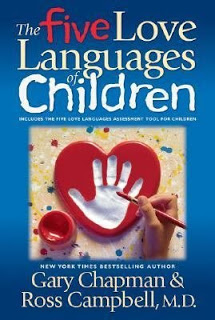
April Series Overview: The Five Love Languages of Children
This workshop comes from the book, Five Love Languages of Children by Dr. Gary Chapman. Thanks to Anderson Hills for sharing the information in a workshop format. This is based on a biblical idea that God loves his people in five ways, and therefore we give and receive love in these ways too.
Have you Read?
The Five Love Languages of Children, Part #4 – Discipline and the Five Love Languages
Keeping a child’s “love tank” full will have an impact on his or her behavior. A child who misbehaves usually has a need for something. Being able to recognize your child’s love language, you are able to address these needs and address it.
According to the book and workshop, In order to respect a child’s love language and discipline (train) with love, do not select their love language as a method of discipline. For example using condemning words with a child’s love language being words of affirmation, words will will communicate not only that you are displeased with their behavior but that you do not love the child. If love language is quality time – do use isolation as form of punishment. If it’s physical touch, don’t withhold hugs or respond in a physically negative way.
5 Methods That Can Be Used to Effectively Discipline With Love
1. Make a Request.
This sends 3 important, nonverbal messages to the child.
- That you respect his feelings
- That you realize that he has a brain and is able to form opinions
- That you expect him to take responsibility for his own behavior
2. Issue a Command when making a Request fails. Issuing commands are more effective when use infrequently and not as the main method for controlling behavior
3. Gentle Physical Manipulation. This is especially effective with young children who often do things that are not necessarily wrong but not to your preference. For example, be careful not to confuse negativity with defiance. When a 2 year-old says, “No!” he is demonstrating a normal stage of development, where he begins to separate psychologically from his parents. If you make a request and he says, “No”, move to a command. If he still says, “No”, you might be inclined to punish him, but instead gently guide him to what you need him to do. If he resists, it’s defiance, so act accordingly, but most often child will go along with your gentle physical manipulation. He was just practicing his independence.
4. Punishment
This is the most negative way of training a child, and the most difficult because:
- The punishment must fit the crime since children have such a wrong sense of fairness
- The punishment has to be appropriate for each particular child
- Punishment is often administered inconsistently according to the punisher’s mood at the time. When you are feeling good, you tend to be more lenient than when you have had a bad day
- Punishment when used primarily as a means of discipline provokes needless anger, and causes the child to develop passive-aggressive attitudes and behaviors.
- If you have to punish the child, give her a conscious expression of love in her primary love language.
5. Behavior Modification
If the child shows no remorse for his behavior, there is the next step. It utilizes three components:
- Positive Reinforcement (giving a reward good behavior)
- Negative Reinforcement (taking something away)
- Punishment (removing the child/isolation)
Behavior modification is best used only for recurring specific problems for which a child shows no remorse. Overuse causes feelings of being unloved because behavior modification is completely based on conditions. This results in a “I have to give to get” attitude and teaches the child how to manipulate authority figures.
Visit the Five Love Languages website, here.
I hope that you enjoyed. Workshop Wednesday will be back again sometime soon!

